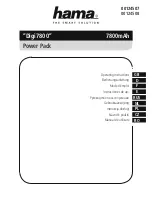
7
SAFETY INFORMATION
Battery tool Use and Care
• Recharge only with the charger specified by the manufacturer.
A charger that is suitable
for one type of battery pack may create a risk of fire when used with another battery pack.
• Use power tools only with specifically designated battery packs.
Use of any other
battery packs may create a risk of injury and fire.
BATTERY PACKS
CHARGERS
KB 124-03; KB 224-03; KB 424-03;
KB 524-03; KB 624-03;
KRC 2445-03; KRC 2490-03;
• When battery pack is not in use, keep it away from other metal objects, like paper
clips, coins, keys, nails, screws or other small metal objects, that can make a
connection from one terminal to another.
Shorting the battery terminals together may
cause burns or a fire.
• Under abusive conditions, liquid may be ejected from the battery; avoid contact. If
contact accidentally occurs, flush with water. If liquid contacts eyes, additionally seek
medical help.
Liquid ejected from the battery may cause irritation or burns.
• Do not use a battery pack or tool that is damaged or modified.
Damaged or modified
batteries may exhibit unpredictable behavior resulting in fire, explosion or risk of injury.
• Do not expose a battery pack or tool to fire or excessive temperature.
Exposure to fire
or temperature above 130 °C may cause explosion.
• Follow all charging instructions and do not charge the battery pack or tool outside the
temperature range specified in the instructions.
Charging improperly or at temperatures
outside the specified range may damage the battery and increase the risk of fire.
Service
• Have your power tool serviced by a qualified repair person using only identical
replacement parts.
This will ensure that the safety of the power tool is maintained.
• Never service damaged battery packs.
Service of battery packs should only be performed
by the manufacturer or authorized service providers.
Specific Safety Warnings for Wrench
• Hold the power tool by insulated gripping surfaces, when performing an operation
where the fastener may contact hidden wiring.
Fasteners contacting a “live” wire may make
exposed metal parts of the power tool “live” and could give the operator an electric shock.
• When working with the power tool, always hold it firmly with both hands and provide
for a secure stance.
The power tool is guided more secure with both hands.
• Secure the workpiece.
A workpiece clamped with clamping devices or in a vice is held
more secure than by hand.
• Always wait until the power tool has come to a complete stop before placing it down.
The tool insert can jam and lead to loss of control over the power tool.








































